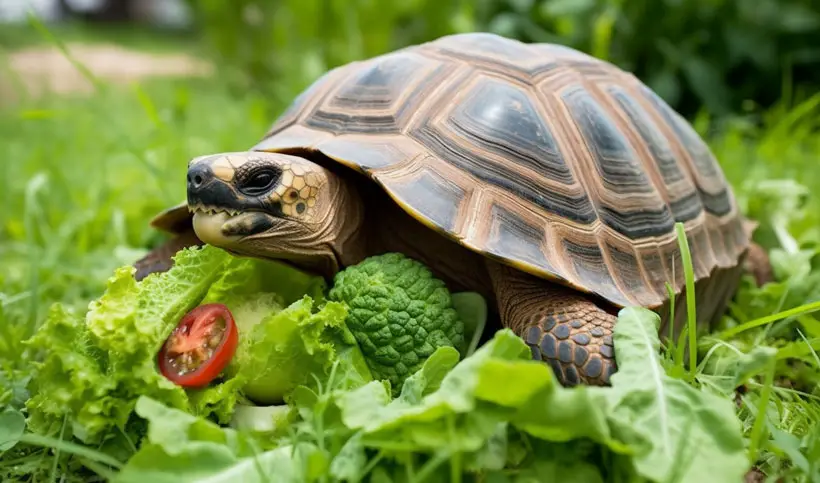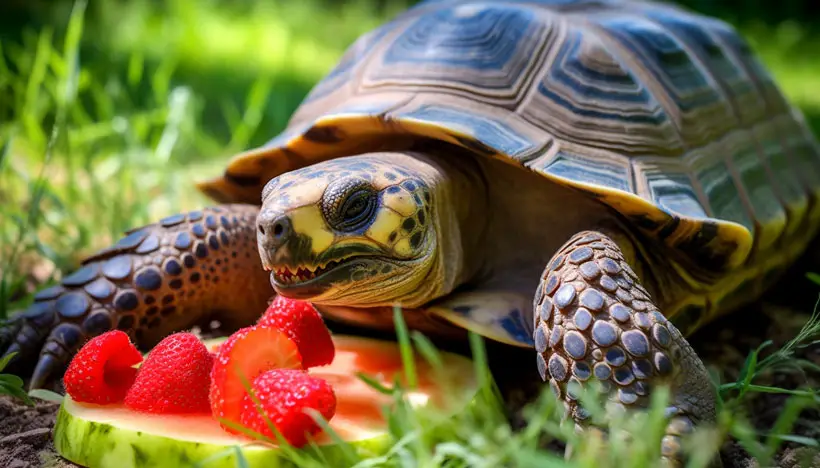Russian Tortoise Diet: What To Feed a Russian Tortoise?
Understanding the appropriate diet for a Russian tortoise is crucial for their overall health and well-being. By providing the right balance of nutrients, you can ensure that your tortoise thrives and maintains optimal vitality.
So what to feed a Russian Tortoise? A Russian tortoise eats mostly fresh greens like dandelion, collard, and mustard greens. Timothy hay and Bermuda grass are a staple for Russian tortoises. Cactus pads, hibiscus, rose petals, and sometimes carrots and berries may provide variation.
Likewise, it’s important to balance protein and vegetables while avoiding hazardous meals. Embark on this educational journey to ensure that your Russian tortoise receives the optimal nutrition they require for a happy and thriving life.
Russian Tortoise Diet: What To Feed a Russian Tortoise?
Contents

Proper nutrition plays a crucial role in maintaining the health and well-being of a Russian tortoise. To ensure their optimal growth and longevity, here is a guide on what to feed your Russian tortoise:
Leafy greens
Leafy greens should make up the bulk of a Russian tortoise’s diet. Offer a variety of options, such as dandelion greens, collard greens, mustard greens, and turnip greens. These provide essential vitamins and minerals while being low in oxalates.
Hay and grasses
Hay and grasses are important sources of fiber for a Russian tortoise’s digestive system. Include Timothy hay, Bermuda grass, and meadow grass in their diet to aid digestion and promote healthy bowel movements.
Vegetables
Supplement their diet with a variety of vegetables. Carrots, squash, bell peppers, and other vegetables can be given in moderation. Ensure they are finely chopped to facilitate consumption.

Cactus pads
Russian tortoises enjoy eating cactus pads, specifically from the Opuntia genus. These pads are not only nutritious but also provide hydration. Remove any thorns before offering them to your tortoise.
Fruits
Offer fruits as occasional treats, as they contain higher sugar content. Suitable options include berries like strawberries and raspberries. Apples can also be given in limited quantities, but remove the seeds and core before feeding.

Edible weeds and flowers
Introduce edible weeds like dandelions, plantains, and clovers into their diet. These provide natural foraging opportunities and contribute to a varied diet. Edible flowers such as hibiscus and rose petals can also be offered in moderation.
Calcium and supplements
Calcium is vital for the development and maintenance of a Russian tortoise’s shell and bones. Ensure a good calcium intake by offering calcium-rich greens like kale and spinach. A cuttlebone or calcium blocks can also be provided for additional calcium supplementation.
Water
Provide fresh, clean water in a shallow dish at all times. Additionally, offer regular bathing opportunities for hydration and to aid in shedding.
Watch this video on the Russian Tortoise diet to know in depth.
Feeding Schedule And Portion Control
Establishing a proper feeding schedule and maintaining portion control are important aspects of ensuring a healthy diet for your Russian tortoise. Here are some guidelines to follow:
Feeding frequency
Offer food to your Russian tortoise every day or every other day, depending on their age and activity level. Younger tortoises may require more frequent feedings, while adult tortoises can be fed less often.

Portion sizes
Provide an appropriate portion size based on the size and age of your tortoise. As a general guideline, the food portion should be about the size of your tortoise’s shell. Avoid overfeeding, as excessive weight gain can lead to health issues.
Here’s a sample table to help you visualize a feeding schedule and portion control for your Russian tortoise:
| Age Range | Feeding Schedule | Portion Size |
|---|---|---|
| Hatchling | Daily | 1-2 tablespoons of greens |
| Juvenile (1-2 years) | Daily or every other day | 2-3 tablespoons of greens |
| Adult (3+ years) | Every other day | 3-4 tablespoons of greens |
Monitor weight
Regularly monitor your tortoise’s weight by using a reliable scale. Maintain a healthy weight range for their species and age. Adjust portion sizes accordingly to prevent obesity or malnutrition.
Variety and balance
Offer a varied diet to ensure nutritional balance. Rotate different types of leafy greens, hay, grasses, and occasional treats to provide a diverse range of nutrients. This helps prevent dietary deficiencies and encourages healthy eating habits.
What Fruits Are Best For Russian Tortoises?

When it comes to feeding fruits to Russian tortoises, it’s important to choose options that are safe and have a suitable nutritional profile. Here are some fruits that are generally considered safe and beneficial for Russian tortoises:
Berries
Strawberries, raspberries, and blueberries are excellent choices. Vitamins and minerals are found in these low-sugar, antioxidant-rich fruits.
Melons
Cut watermelon, cantaloupe, and honeydew into bite-sized chunks. These hydrated fruits provide vitamin C.
Papaya
This tropical fruit provides digestive enzymes and fiber. It can be offered occasionally in small quantities.
Mango
Mango is a tasty treat for Russian tortoises. It is rich in vitamins A and C, which are beneficial for their overall health.
Apple
Apples can be given in small quantities, but make sure to remove the seeds and core as they can be toxic to tortoises. Cut the apple into small, bite-sized pieces for easy consumption.
What Do Baby Russian Tortoises Eat?

Baby Russian tortoises have specific dietary needs to support their growth and development. Here is a special diet for baby Russian tortoises:
High protein content
Baby Russian tortoises need more protein than adults to develop quickly. Small portions of cooked lean meats like chicken or turkey or commercial tortoise pellets for young tortoises are protein-rich.
Calcium to phosphorus ratio
Maintaining the right balance of calcium and phosphorus is crucial for healthy shell development. Offer calcium-rich foods such as calcium carbonate powder sprinkled on their food. Avoid feeding foods high in phosphorus, such as spinach and beet greens, as these can interfere with calcium absorption.
What Foods Are Poisonous To Russian Tortoises?

Russian tortoises, like other reptiles, have specific dietary requirements and are susceptible to certain foods that can be toxic to them. It is important to avoid feeding the following foods to Russian tortoises:
Toxic plants
Certain plants are toxic to Russian tortoises and should be avoided. Examples include azaleas, rhododendrons, ivy, lilies, oleander, and yew. Always ensure that the plants in the tortoise’s enclosure are non-toxic and free from pesticides.
Avocado
Avocado contains a toxin called persin, which can be harmful to Russian tortoises. Avoid feeding any part of the avocado, including the flesh, skin, and pit.
Rhubarb leaves
Rhubarb leaves contain high levels of oxalates, which can be toxic to Russian tortoises. Avoid feeding any part of the rhubarb plant, including the leaves and stalks.
Onions and garlic
Onions and garlic, along with other plants from the Allium family, can cause anemia and digestive issues in Russian tortoises. It is best to avoid feeding them these foods.
Mushrooms
Wild mushrooms can be toxic to Russian tortoises, and it can be challenging to identify which varieties are safe. It is safest to avoid feeding any mushrooms to your tortoise.
Dairy products and meat
Russian tortoises are herbivores and do not possess the digestive enzymes to break down dairy products or meat. Avoid feeding them any form of dairy or meat.
Processed foods
Avoid offering processed foods, sugary snacks, and human food items to your Russian tortoise. These foods are not part of their natural diet and can be harmful to their health.
It’s important to research and ensure that any food offered to your Russian tortoise is safe and appropriate for its species.
FAQs
Here are some additional frequently asked questions (FAQs) for your knowledge.
Yes, commercial tortoise pellets can be included in a Russian tortoise’s diet as part of a balanced nutrition plan. However, they should not be the sole source of food. Use high-quality pellets specifically formulated for Russian tortoises.
Ensure they contain a suitable balance of fiber, protein, and other essential nutrients. Pellets should be supplemented with fresh vegetables and leafy greens for a well-rounded diet.
Russian tortoises are primarily herbivores. Their normal food has a lot of calcium-rich sources and a lot of grain. In the wild, Russian tortoises never eat meat or bugs. If you keep one as a pet, you should avoid giving it these foods.
Their nutritional needs can be adequately met with a well-balanced plant-based diet.
It is essential to offer a varied diet to ensure that your Russian tortoise receives a wide range of nutrients. Aim to provide a diverse selection of leafy greens, vegetables, and occasional fruits. Varying their diet not only prevents boredom but also helps meet their nutritional needs.
However, sudden and drastic changes in diet can cause digestive issues, so it’s best to introduce new foods gradually and observe their response.
Final Thoughts
In conclusion, understanding the dietary needs of a Russian tortoise is essential for their health and well-being. A balanced diet consisting of leafy greens, hay, grasses, vegetables, occasional fruits, and edible flowers provides the nutrients for optimal growth and vitality.
It’s important to establish a feeding schedule, practice portion control, and avoid toxic foods. By following these guidelines, you can ensure that your Russian tortoise receives the proper nutrition for a happy and thriving life.

